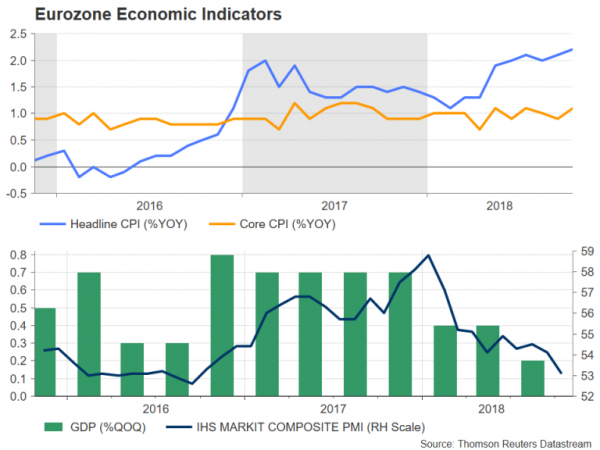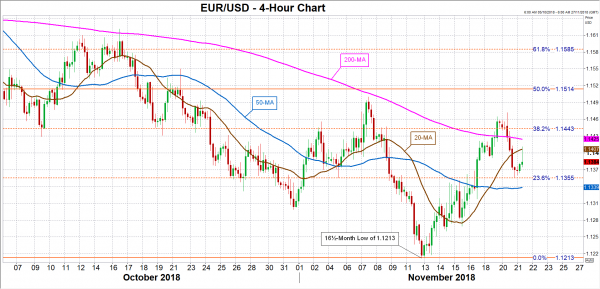The European Central Bank will publish the account of its October 25 monetary policy meeting on Thursday at 12:30 GMT. With the Eurozone economy stuck in the doldrums, investors will be watching for any hint of misgivings by Governing Council members about the bank’s policy normalization plans. In the meantime, though, the euro has managed to find some reprieve from a weaker US dollar to recover around the $1.14 handle.
As a rebound in Eurozone growth momentum becomes ever more elusive, the ECB has so far stayed on course and plans to pull the plug on its asset purchase program at the end of December and begin raising interest rates sometime in Q4 2019. ECB chief, Mario Draghi, insists that the overall risks to the growth outlook are “broadly balanced” despite the sluggish performance during the year.
However, there are some signs that policymakers are becoming a little more receptive to the long stretch of negative economic releases out of the Eurozone. Speaking in Frankfurt earlier this month, Draghi said that if the inflation outlook worsens, this would “be reflected in an adjustment in the expected path of future interest rates”.
The latest growth indicators suggest there is no end yet to the Eurozone’s slow patch. Third quarter GDP growth was dismal, at just 0.2% quarter-on-quarter, and the bloc’s powerhouse, Germany fared even worse, with the economy contracting by 0.2%. However, there is some cautious optimism about the final three months of 2018 and for 2019. The flash estimates of IHS Markit’s closely-watched PMIs are expected to show the growth deceleration stabilizing in November, while most economists in a recent Reuters poll are predicting a rebound in growth in the final three months of the year.
In further support of the ECB’s outlook, inflation data haven’t been as disappointing as those for growth. Headline inflation in the euro area is running slightly above 2% and underlying inflation ticked higher in October. The ECB is also encouraged by falling unemployment and sustained wage increases in the Eurozone.
But even if growth picks up a gear or two and underlying inflationary pressures continue to gather pace, there are still several risks hanging over the region’s economy, which will likely prevail through 2019. US trade protectionism and a slowing Chinese economy are the major external headwinds for the Eurozone economy, given its export-reliant nature. Closer to home, the clash between the Italian government and the European Commission over Italy’s budget deficit targets and the potential for this to blow into a full-blown crisis could dampen business sentiment across the bloc for months to come.
The gloomier growth outlook and heightened investor angst from the above risks have already started to be reflected in interest rate futures markets. Traders are barely fully pricing a rate hike of 10 basis points in the ECB’s deposit rate before the end of 2019, highlighting the growing doubts about how soon the ECB would be in a position to start raising rates.
Thursday’s minutes should provide some insight as to whether policymakers remain firmly committed to their current timeline or are becoming more cautious about their projected rate hike path. Any dovish inclination in the minutes could see euro/dollar breaking below immediate support at the 23.6% Fibonacci retracement of the downleg from 1.1815 to 1.1213 at 1.1355. Not too far below lies the 50-period moving average around 1.1340, which if breached, would shift the near-term bias for the pair back to a bearish one and accelerate the declines towards November’s 16½-month low of 1.1213.
On the other hand, any suggestion in the October meeting account that only a dramatic deterioration of the outlook would steer the ECB off its current course could help the euro resume its recent uptrend versus the greenback. Euro/dollar could climb back towards this week’s two-week high of 1.1472. But first, it would have to overcome immediate resistance at the 20-period moving average just above the psychological 1.14 mark, followed by the 38.2% Fibonacci at 1.1443. Clearing these hurdles would bring into view the 50% Fibonacci of 1.1514. A break above the 50% Fibonacci would strengthen the pair’s upside momentum.















